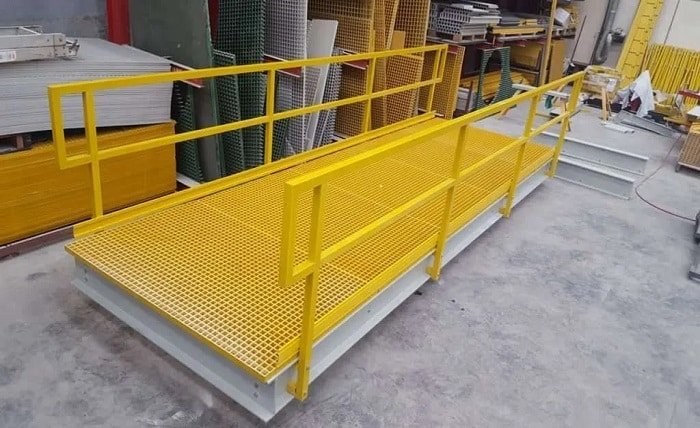Introduction
Across Australia, the demand for infrastructure that combines safety, durability, and accessibility has driven interest in FRP materials. Made from Fiber Reinforced Polymer, FRP materials are known for their resistance to corrosion, lightweight properties, and adaptability in tough environments. These qualities make FRP materials a reliable choice for industrial and public infrastructure projects that must meet strict Australian standards. In this article, we’ll explore why FRP materials are an ideal solution for building long-lasting, safe, and accessible public spaces.
What Are FRP Materials and Why Are They Ideal for Infrastructure?
Understanding FRP Materials in Construction
FRP materials consist of high-strength fibers reinforced within a polymer matrix. This composite structure results in a product that’s not only lightweight but also exceptionally strong and resistant to environmental wear. In infrastructure applications, FRP materials withstand moisture, chemical exposure, and UV damage better than many traditional materials. As a result, they are particularly well-suited for outdoor installations in Australia’s varied climate, from urban pedestrian walkways to coastal barriers.
FRP vs. Traditional Construction Materials
FRP materials offer clear advantages over traditional materials like steel, wood, and concrete. Steel, while strong, is prone to corrosion, especially in coastal or industrial areas, and concrete, though durable, requires regular maintenance to prevent cracking. FRP materials, on the other hand, provide a corrosion-resistant, long-lasting solution that doesn’t require constant upkeep. Their lightweight properties also make them easier to handle and install, reducing both labor and project time, especially when constructing large-scale or elevated structures. For more on how FRP materials meet Australian infrastructure standards, visit this guide.
Key Benefits of FRP Materials for Safe, Accessible Infrastructure
Durability and Long-Term Performance
One of the most valued qualities of FRP materials is their ability to endure harsh weather, UV exposure, and contact with chemicals, making them a top choice for long-term infrastructure projects. Unlike wood that rots or steel that rusts, FRP requires minimal maintenance, which translates to significant savings in labor and replacement costs over time. This durability ensures that public infrastructure, from footbridges to railings, remains safe and accessible, meeting public safety standards without needing frequent repairs or replacements.
Lightweight and Accessible Design
FRP materials are much lighter than traditional options like steel or concrete, which provides several benefits in accessible infrastructure projects. Being lightweight makes FRP easier to transport, lift, and install—particularly valuable in projects involving elevated walkways, ramps, or railings. This reduction in handling complexity speeds up installation and minimizes labor costs. In addition, FRP’s ease of installation allows infrastructure teams to deliver accessible structures that meet safety standards without the need for extensive equipment, making it a cost-effective option in both large and small projects.
Applications of FRP Materials in Australian Infrastructure
Meeting Australian Standards for Safety and Accessibility
FRP materials are used extensively in infrastructure projects that require compliance with Australian safety and accessibility standards. For example, FRP is often selected for pedestrian bridges, public walkways, and ramps, where both safety and accessibility are essential. FRP’s slip-resistant surface enhances safety, particularly in areas exposed to rain or moisture. Its non-conductive properties also make FRP an excellent choice for settings where electrical hazards are a concern, providing an extra layer of safety for users.
Case Studies of FRP in Australian Infrastructure
FRP materials have been successfully implemented in numerous Australian infrastructure projects. In one example, a coastal pedestrian bridge replaced traditional metal grating with FRP, significantly reducing maintenance costs while improving safety for users. The FRP materials performed well in the humid, salt-rich environment, demonstrating resilience against corrosion and the elements. Similarly, an elevated walkway project in a busy metropolitan area utilized FRP to meet accessibility standards, creating a slip-resistant, lightweight pathway that required minimal installation time. These real-world applications highlight FRP’s versatility and effectiveness in meeting Australia’s infrastructure needs.
The Future of FRP Materials in Australian Infrastructure
Sustainable Benefits of FRP Materials
FRP materials play an important role in sustainable construction. Their durability reduces the need for frequent replacements, which minimizes waste and conserves resources over the lifespan of an infrastructure project. Additionally, FRP materials do not require chemical treatments or coatings to maintain their properties, making them environmentally safer than materials that need regular treatments. By supporting the longevity and environmental sustainability of infrastructure, FRP aligns with the growing emphasis on eco-friendly building practices.
Advancing Infrastructure Safety and Accessibility with FRP
The demand for infrastructure that prioritizes both safety and accessibility is driving increased adoption of FRP materials across Australia. FRP’s slip-resistant and non-conductive properties enhance safety, while its lightweight, easy-to-install design supports accessible construction practices. As Australian standards for infrastructure safety and accessibility continue to evolve, FRP materials are well-positioned to remain a core component of modern construction, providing reliable, user-friendly solutions for public spaces and industrial applications alike.
Conclusion
FRP materials are reshaping the landscape of Australian infrastructure, offering unmatched durability, safety, and accessibility for public spaces and industrial projects. Their corrosion resistance, low maintenance needs, and lightweight properties make FRP materials an excellent choice for projects that must meet strict standards. As industries continue to prioritize sustainable, safe, and accessible infrastructure, FRP materials stand out as a forward-thinking solution that will support Australia’s infrastructure needs for decades to come.
Frequently Asked Questions (FAQs)
Q1: What makes FRP materials suitable for accessible infrastructure? A1: FRP materials are lightweight, corrosion-resistant, and easy to install, making them ideal for creating accessible public infrastructure that meets safety standards.
Q2: How does FRP compare to traditional materials like steel and concrete? A2: Unlike steel, which corrodes, and concrete, which can crack, FRP materials are non-corrosive, durable, and require minimal maintenance. This makes them cost-effective and reliable for long-term use.
Q3: Are FRP materials sustainable? A3: Yes, FRP materials have a long lifespan, reducing the need for frequent replacements and minimizing waste. Their maintenance-free properties also support sustainable building practices by lowering the need for chemical treatments.
Q4: Can FRP materials meet Australian safety standards? A4: FRP materials are designed to meet Australian safety and accessibility standards, featuring slip-resistant and non-conductive properties that enhance safety in public infrastructure.





